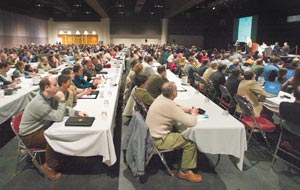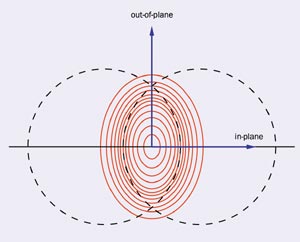The Quark Matter 2004 conference, held in Oakland, California, in January, provided participants with evidence for the elusive quark-gluon plasma. Spencer Klein and Joakim Nystrand describe the highlights of the meeting.

Held every 18 months, Quark Matter is the major conference covering relativistic heavy-ion collisions. The latest in the series – Quark Matter 2004 – took place on 10–17 January at the Oakland Convention Center in California and was co-chaired by Hans Georg Ritter and Xin-Nian Wang from Lawrence Berkeley National Laboratory (LBNL). The meeting featured a flood of new data from the Relativistic Heavy Ion Collider (RHIC) at Brookhaven National Laboratory, along with continuing analyses from experiments at CERN’s Super Proton Synchrotron (SPS) and reports from the HERA-B and HERMES experiments at DESY.
The conference – which was preceded by two well attended and well received workshops, one for graduate students and the other for local high-school teachers – was officially opened by Jerry Brown, Oakland’s mayor and ex-governor of California. Reinhard Stock of IFK Frankfurt opened the scientific programme with a historical overview of heavy-ion collisions, which was followed by theoretical and experimental introductions by Urs Wiedemann of CERN and Tom Hemmick of SUNY, Stony Brook, respectively. So began five days of parallel and plenary sessions, and while everything cannot be described here in detail, the following aims to provide a flavour.
The biggest question at recent Quark Matter conferences has been: have we found the quark-gluon plasma? Although the collaborations working at RHIC have made no definitive statements, the sense among the participants this year was that for the first time the answer is “yes”. A broad range of measurements painted a picture that most attendees found convincing: strong suppression of high transverse momentum (pT) particles, the absence of back-to-back jets, anisotropies consistent with strong, hydrodynamic flow, and many other observations. The data show that a dense medium is produced in the collisions and that particles interact strongly and lose energy as they traverse it. The observed energy loss requires a very dense medium, which seems incompatible with the presence of hadrons. The observed anisotropies (in flow) for different particle species indicate that the medium behaves like an almost perfect fluid, as expected from a quark-gluon plasma (QGP). A comparison of the anisotropies of different species suggests that equilibration is rapid and thus likely occurs during the partonic stage.

Many of these effects were already seen at the Quark Matter 2002 conference, held in Nantes, France. Since then RHIC has taken and analysed data on deuterium-gold (dAu) collisions, providing a key control. In dAu collisions the number of nucleon-nucleon collisions is small and the energy density is expected to be too low to form a QGP. The putative QGP signatures were absent in the dAu data, showing that the phenomena are final-state effects. These effects were also absent (in the case of high-pT particle suppression) or greatly reduced (for flow) in lower energy collisions.
Hard probes of ion collisions
Perhaps the most striking result to come out of RHIC so far is the strong suppression of mesons with high pT observed in central nucleus–nucleus collisions (i.e. collisions where the nuclei fully overlap). The production of hadrons with pT above approximately 2-3 GeV/c in proton-proton collisions is well described by perturbative quantum chromodynamics (QCD). If heavy-ion collisions were mere superpositions of individual nucleon–nucleon collisions, the particle yield at high pT would scale with the number of binary collisions. David d’Enterria of Columbia reviewed RHIC data showing that particle production is suppressed by about a factor of five relative to a nucleon–nucleon superposition. This suppression is not seen in dAu or lower energy ion-ion collisions. Carsten Greiner of Frankfurt discussed hadronic final-state interactions and concluded that hadronic interactions alone could not explain the data.
Julia Velkovska of Vanderbilt reviewed measurements of high-pT particle suppression for different particle species. Above 6 GeV/c all particle species show comparable suppression. However, at intermediate momenta (2 < pT < 5 GeV/c) only mesons are suppressed. In hydrodynamic models bulk radial expansion equalizes velocities, boosting the number of heavy particles at intermediate pT. In this model the φ meson and the proton would therefore have the same suppression. Rainer Fries of Minnesota presented an alternate scenario, where the baryons are produced by recombination of already existing quarks. This recombination may explain the intermediate-pT data.

With the dAu data ruling out initial-state effects, the study of high-pT particles in nucleus-nucleus collisions has largely evolved into “jet tomography”, where the jets probe the matter produced in the collisions. The experimental and theoretical aspects of this technology were reviewed by Mike Miller of Yale and Ivan Vitev of Iowa State, respectively. In proton-proton collisions jets are usually created back-to-back; this back-to-back topology is observable as correlations between high-pT particles. In gold–gold collisions the correlations disappear, perhaps because one of the produced jets is absorbed in the medium. Transverse-momentum conservation requires that the energy in the quenched jet does not disappear but is redistributed. This redistributed energy may have been seen in low-momentum particles.
Both the STAR and PHENIX collaborations at RHIC have studied the quenching of the away-side jet relative to the reaction plane – the plane spanned by the beam axis and the impact parameter (see figure 1). This study used data from glancing collisions, where some back-to-back correlations remained. As expected, if the suppression is caused by energy loss in the dense nuclear medium, the quenching is strongest when the jet is perpendicular to the reaction plane (long path through medium) and weaker when the jet is in the reaction plane (short path through medium). The results from STAR are shown in figure 2.
The dense matter produced in the collisions can also be studied through direct photons, which are emitted as the system cools. There is, however, a huge background from photons produced in hadronic decays, particularly from π0 and η mesons. This background must be carefully measured and subtracted. Justin Frantz of Columbia presented results from PHENIX on direct photons (see figure 3). For pT > 5 GeV/c the yield agrees with a calculation based on perturbative QCD, another strong indication that high-pT parton production is well understood, and that the suppression of high-pT hadrons is indeed due to interactions in the dense matter. Direct photons at intermediate pT may also be emitted from the QGP, as was discussed by Guy Moore of McGill, but current results are not precise enough to probe this region.

Suppression of J/Ψ production was one of the first proposed signals for the QGP, and has long been studied at CERN’s SPS. Goncalo Borges of LIP, Lisbon, presented the latest results from NA50. Again proton-ion or deuteron-ion data are important references to measure both the hadronic absorption in ordinary nuclear matter and the effects of modifications to the gluon distribution function in heavy nuclei (shadowing). The PHENIX collaboration presented data on J/Ψ production in dAu collisions at RHIC, supporting moderate gluon shadowing and little hadronic absorption. An Tai of the University of California, Los Angeles, presented the first measurements of fully reconstructed open charm at RHIC made by the STAR collaboration, and Melynda Brooks of Los Alamos National Laboratory also reviewed charm measurements at RHIC and the SPS.
Soft particle production
Most of the particles observed in a detector are produced very late in the collision, at a time known as “freezeout”. Federico Antinori of INFN Padova showed that the particle abundances are generally well described by a thermal model, with no strangeness enhancement or suppression. The particle ratios depend only on the particle mass and temperature. The enhanced strangeness production compared with proton–proton collisions could be due to the difference between global strangeness conservation in a large system (i.e. a grand canonical distribution) and local conservation in a small system (the canonical distribution). Global conservation allows single strange-quark production (with strangeness conservation imposed on the final state), while in a small system strange quarks are produced in pairs. The properties of the final state were discussed by Gunther Roland of MIT and Andrzej Rybicki of Krakow.

The spectra of the short-lived resonances (K*, ρ, f0(975), Δ, Σ*(1385), and Λ(1520)) were presented by Patricia Fachini of Brookhaven. Some short-lived resonances may be less abundant than the thermal-model predictions. This could happen when daughter particles rescatter during the period between chemical freezeout, when particle production stops, and thermal freezeout, when elastic scattering stops. The PHENIX collaboration has compared the hadronic (K+K–) and leptonic (e+e–) decays of the φ-meson and sees no evidence for a shift in mass or branching ratio.
One striking phenomenon observed at RHIC is non-isotropic flow. The overlap between two colliding ions forms an elliptical region (see figure 1). Tetsufumi Hirano of the Riken BNL Research Center explained how high pressure turns this spatial anisotropy into an anisotropy in momentum space. Some years ago it was expected that this flow would be negligible at high energies; it is in fact stronger at RHIC than at lower energies. Fabrice Retiere of LBNL compared data from all four RHIC experiments, showing that the observed flow of different particle species is consistent with thermodynamic models that treat the system like an almost perfect fluid. The Λ and kaon flow are particularly interesting: the Λ flow is the same as the kaon flow at two-thirds of the momentum; an observation clearly pointing to interactions involving partons. Much time was spent discussing how to reconcile these macroscopic approaches with microscopic pictures based on hadronic or partonic shower simulations.
The size of the interacting system can be measured by studying correlations among identical particles. The enhanced production of bosons with similar momenta can be used to measure the source size via Hanbury-Brown Twiss (HBT) interferometry. Dan Magestro of Ohio State noted that HBT studies are perhaps the least-understood measurement made at RHIC. The experiments at RHIC have found that the system is small, with a Gaussian radius of around 6 fm and a lifetime of 8–10 fm/c. This small size and short lifetime is difficult to reconcile with the observed collective flow. Measurements by the STAR collaboration of HBT parameters with respect to the reaction plane show that the initial eccentricity of the reaction volume survives to the final-state HBT measurements.
Jeff Mitchell of BNL reviewed studies of the event-to-event variations of a variety of observables. Most of the fluctuations can be understood as normal statistical variations, but non-statistical fluctuations have also been confirmed, e.g. in mean pT. These may be due to jet production.
Do gluons condense?
A secondary theme at the conference was the study of parton distributions at low-x (fractional parton momentum) and a postulated new state of matter, the “coloured glass condensate” or CGC. Jamal Jalilian-Marian from the University of Washington explained that the condensate may form at very high gluon densities, i.e. at low-x, especially in heavy nuclei. When gluons saturate the available transverse phase space, they recombine and their density is reduced. These gluon fields might be describable classically. Measurements at HERA of low-x gluon densities and the surprisingly low multiplicities seen at RHIC were previously cited as evidence for the CGC. The BRAHMS collaboration presented two pieces of evidence regarding the CGC. Their charged-particle rapidity distribution for dAu collisions does not match the CGC predictions. Ramiro Debbe of Brookhaven showed that forward production of high-pT particles in dAu collisions is suppressed, as expected for a CGC. However, despite strong advocacy by proponents of the CGC, many at the conference felt that more quantitative studies are needed before alternative explanations can be ruled out.
And now for something completely different
Although the main goal of colliding heavy ions is to detect and study the QGP, many other aspects of high-energy physics can be studied in these collisions. One example concerns the observations of a new particle with a mass of about 1540 MeV and a narrow width, which has been reported by several experiments. Robert Jaffe of MIT explained that the results are consistent with the expectations for a pentaquark state (a bound state of five valence quarks), known as the Θ+.
Chris Pinkenburg of Brookhaven reported that the PHENIX collaboration has observed an enhancement consistent with an anti-Θ particle decaying into an anti-neutron and a K–. The anti-neutrons were detected with the PHENIX electromagnetic calorimeters and the flight time was used to determine their energy. If confirmed, this would be the first observation of an anti-pentaquark. The NA49 experiment at CERN’s SPS has found a signal for the doubly strange Ξ— pentaquark in the decay Ξ— → Ξ– + π–. However, the HERA-B experiment at DESY has searched for the Θ+ particle in proton-nucleus collisions, but found no signal.
In addition to studying the hadronic reactions, the STAR collaboration has also investigated the photoproduction of ρ0 mesons in gold–gold collisions at RHIC. In contrast to the electron-nucleus reactions, the photoproduction in a heavy-ion reaction can occur at either of the two beam nuclei. For very small transverse momenta the amplitudes from the two sources interfere destructively. Since the ρ0 lifetime is short when compared with the typical ion-ion separation, the observation of this interference indicates that the ρ0 wave function is preserved long after the decay into two pions took place.
Looking to the future
With fairly broad agreement that we have finally seen QGP, future studies will focus on measuring its properties. Yves Schutz of the E´cole des Mines de Nantes previewed the future in his talk on heavy ions at the Large Hadron Collider. Groups in the ALICE, CMS and ATLAS collaborations are all interested in heavy ions. With regard to RHIC, Axel Drees of SUNY, Stony Brook, showed plans for major detector upgrades and an electron cooling ring to increase the luminosity by a factor of 40. Around 2015–2020 RHIC could add an electron ring to study electron-ion collisions. In the nearer future, however, we can look forward to Quark Matter 2005, which will be held on 1–6 August 2005, in Budapest, Hungary.





